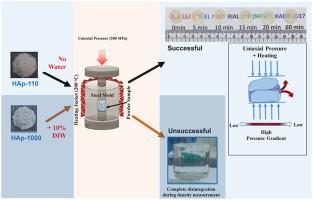Journal of Materials Research and Technology ( IF 6.4 ) Pub Date : 2021-01-23 , DOI: 10.1016/j.jmrt.2021.01.060 Muhmood ul Hassan , Muhammad Akmal , Ho Jin Ryu

|
A novel low-temperature densification method of nanocrystalline calcium hydroxyapatite (HAp) at a temperature as low as 200 °C with no liquid additives is investigated. To understand the underlying mechanism of the low-temperature sintering of hydroxyapatite, two types of lab-synthesized nanocrystalline HAp, dried (110 °C, 12 h) and calcined (1000 °C, 2 h), were subjected to cold sintering conditions (200 °C, 500 MPa) and compared thoroughly. The dried samples were found to be nanocrystalline, enveloped by an amorphous shell, whereas the calcined samples were fully crystalline, as confirmed by X-ray diffraction, transmission electron microscopy, and solid-state nuclear magnetic resonance techniques. A relative density of 98.8% was achieved for the dried samples; however, the calcined samples could not be sintered. This indicates a clear dependence of densification on the surface chemistry of the nanocrystals involving rearrangement and dehydration of the amorphous layer present on the surface of the nanocrystals under the influence of applied pressure and temperature. Moreover, the calcined sample, which had a fully developed crystalline structure, did not undergo sintering, even with the use of added water. Therefore, it is demonstrated that wet-precipitated and dried nanocrystalline HAp can be cold-sintered to full densification for applications in biomedical materials or radioactive waste immobilization of volatile radionuclides at a considerably low temperature, without the addition of sintering aids.
中文翻译:

不使用添加剂的干法纳米结构羟基磷灰石冷烧结
研究了一种新颖的低温致密化纳米晶羟基磷灰石钙(HAp)的方法,该方法可在低至200°C的温度下不添加液体添加剂。为了了解羟基磷灰石低温烧结的基本机理,将两种类型的实验室合成的纳米晶HAp分别在冷烧结条件下进行干燥(110°C,12 h)和煅烧(1000°C,2 h)。 200°C,500 MPa)并进行彻底比较。经X射线衍射,透射电子显微镜和固态核磁共振技术证实,干燥后的样品为纳米晶,被无定形壳包裹,而煅烧后的样品为全晶。干燥样品的相对密度为98.8%;但是,煅烧后的样品无法烧结。这表明致密化对纳米晶体表面化学的明显依赖性,包括在施加的压力和温度的影响下,存在于纳米晶体表面上的非晶层的重排和脱水。此外,具有完全形成的晶体结构的煅烧样品即使使用添加的水也不会进行烧结。因此,证明了可以将湿沉淀和干燥的纳米晶HAp冷烧结至完全致密化,以用于生物医学材料或在相当低的温度下固定挥发性放射性核素的放射性废物,而无需添加烧结助剂。



























 京公网安备 11010802027423号
京公网安备 11010802027423号